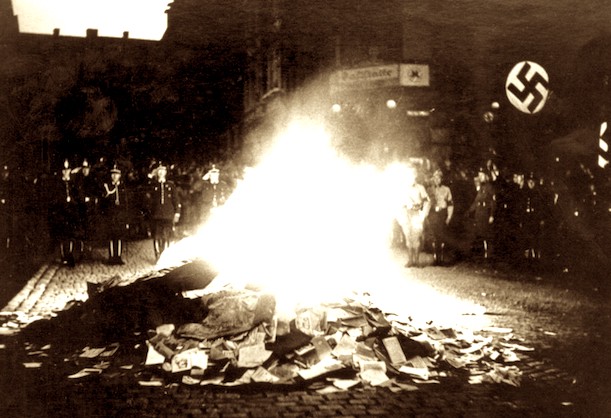Home » Europe, History, Manipulation » Turns Out the Germans did Not burn the Lublin Library in Poland During WW2 After All

Despite the fact that Jewish ‘scholars’ themselves have thoroughly discredited the long-held “historical fact” that “Nazis” burned the entire yeshiva Library in Lublin, Poland, in 1939, many Jewish “historians” still insist that it happened — and then they wonder how any “sane” and “honest” person could question any aspect of their sacred so-called “Holocaust”:
In 1242, King Louis IX of France — subsequently made a saint for his “good deed” — ordered the burning of 24 cartloads of copies of the Talmud and other Hebrew manuscripts amounting to 2,000 volumes. This was a predecessor to the Nazis’ burning of Jewish texts. The Nazis entered Lublin in 1939, where they planned to established a forced relocation camp for Polish Jews. Among the Nazis’ first acts was to burn Lublin’s Great Library with 55,000 volumes.
Recently, when Paris’ Cathedral of Notre Dame was ravaged by flames, one crazy, apocalyptic rabbi pronounced that the disaster was belated divine retribution for Saint Louis’ long-ago sacrilege against Judaism.
It should be understood that, almost always, medieval burnings of Jewish holy books were preceded by disputations, ordered by the Church authorities, to prove that Jesus was the Messiah and that the Talmud was heretical and a blasphemy against Christianity. With one exception discussed below, the rabbis compelled by church prelates to defend the Talmud were forbidden to argue anything contrary to Christian doctrine.
Typically, prominent Jewish converts to Christianity played a role in promoting such perverse disputations. The beginning was in France in 1236, when the apostate Nicholas Donin journeyed to Rome to convince Pope Gregory IX that among the Talmud’s many outrages was abandoning the Hebrew Scriptures and discouraging Jews from converting to Christianity. In 1239 (exactly 700 years before the Nazis torched Lublin’s Great Library), Pope Gregory sent a circular letter to France ordering the Dominicans and Franciscans to burn at the stake “those books in which you find errors,” as was done in 1242. In 1306, the Jews were expelled from France.
The most famous disputation (made into a 1968 television drama) occurred in Barcelona in 1263. There, another Jewish convert, Pablo Christiani (called Friar Paul), told King James I of Aragon that he could prove Christianity was true and the Talmud false using the Hebrew Bible. The king got the the famed rabbi Moses ben Nachman (“Ramban”) to participate after agreeing that the rabbi would have unconstrained freedom of speech.
Ramban demolished Friar Paul and his arguments (Hyam Maccoby and David Berger have edited accounts of this debate), causing the king to award him 300 gold coins. Nevertheless, James I later ordered that pages of the Talmud found sacrilegious be consigned to the flames. Perhaps fearing the same fate, Ramban at 72 years of age made aliyah to Jerusalem, where he established his own synagogue, which endured until the Arabs bombed it in 1948.
Isaac ben Moses ha-Levi, forced during the Seville Riots of 1391 to convert to Christianity and adopt the name Profiat Duran, subsequently wrote a letter, Al Tehi Ka-Aboteka (“Be Not Like Thy Fathers”) whose satire of Christianity is “hidden between the lines.” He employed the techniques of insinuation and irony (analyzed by Leo Strauss in Persecution and the Art of Writing) so well that Christians at first thought this work was truly a defense of their religion. When they discovered otherwise, they burned it.
Disputations followed by condemnations of the Talmud continued into the 15th century. Pope Eugenius IV even prohibited Jews from studying the Talmud after 1449’s Council of Basel. This decree, however, was unevenly enforced.
Jewish tears of devotion doused the medieval flames, prevailing to save the Talmud at least until the Nazis tried to complete the work of the medieval book burners.
As the Jews have told it, the “Nazis” lit a bonfire and burned 55,000 books in the courtyard of the yeshiva — and the cries of the onlooking distraught Jews were so loud that the “Nazis” ordered a brass band — that just happened to be on hand — to drown them out.
Of course, this is a common theme among Jewish “survivor” accounts — the “Nazis” had a demonic proclivity to play teutonic German music while gleefully torturing and murdering Jews in all sorts of creatively sadistic ways.
In reality, books with the Lublin Library imprint have shown up for sale at Jewish auction houses over the years — and many libraries have books from that collection in their inventories — according to Jews who have tracked them down.
But for the Jews, it isn’t important what the “Nazis” actually did or did not do — what’s of prime importance is how the “Nazis” made the Jews feel — and Jews are master alchemists at morphing their feelings into reality — and then using their terrible power of the purse to make sure we all accept that reality.
And when we agree to their version of reality, it appears to have a counter-intuitive salubrious effect on their well-being.
Please wait…
RELATED ARTICLES
Did you like this information? Then please consider making a donation or subscribing to our Newsletter.
Related posts:
Views: 0
 RSS Feed
RSS Feed

















 November 25th, 2020
November 25th, 2020  Awake Goy
Awake Goy 
 Posted in
Posted in  Tags:
Tags: 
















